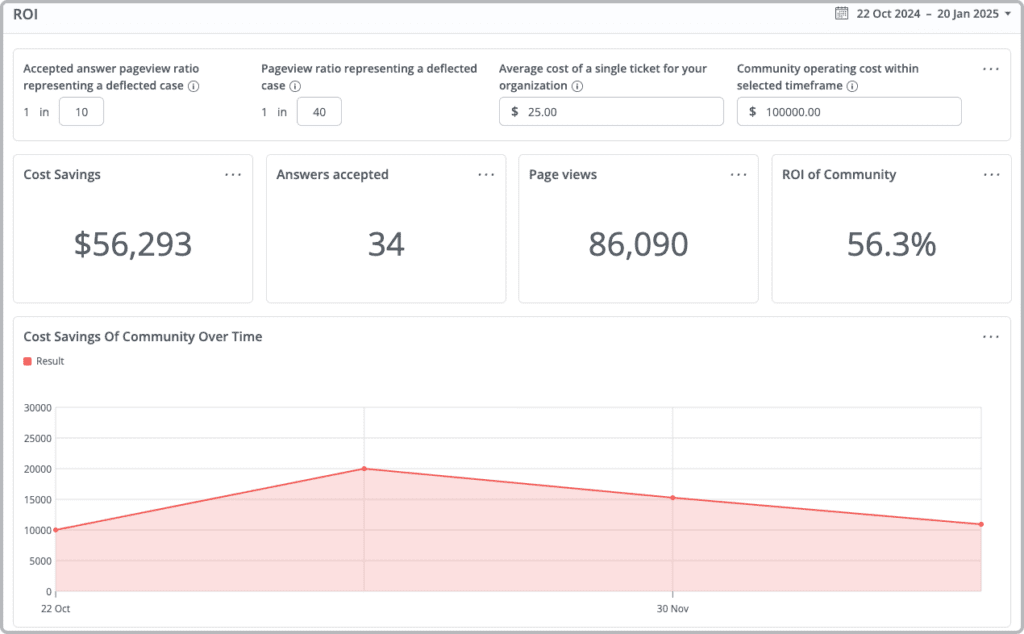
How to Measure the ROI of Community Engagement: A Guide
Proving the value of your online community isn’t always straightforward.
You know your community contributes to business outcomes, whether it’s customer retention, cost savings, or revenue growth. But when leadership asks for ROI numbers, pulling a single report rarely tells the whole story.
That’s because communities, like many other initiatives (marketing, product, support), influence outcomes through a web of touchpoints. They’re seldom the sole driver behind a conversion or renewal. Instead, their value accumulates across different departments and customer moments, often over long periods of time.
That said, it is possible to measure your community’s business impact. You just need to take a blended approach, combining multiple types of data points and acknowledging that some forms of impact are clearer to quantify than others.
Here’s how to build that approach.
Why Community ROI Isn’t Simple to Measure
Community-driven ROI often lives in the gray area.
Some community metrics offer easier ways to connect activity to outcomes, like lead generation from community referrals or product feedback that results in new features and revenue opportunities. But other outcomes, like improved retention or lower support costs, rely on indirect indicators and modeling.
That’s not unique to communities. Marketing attribution models, support cost calculations, and product influence metrics all carry similar challenges. They’re based on correlations, comparisons, and informed assumptions, not one-to-one cause and effect.
Rather than aiming for perfect attribution, focus on building a holistic picture. Track both short-term signals and long-term results, and look at how community engagement correlates with broader business trends.
Community ROI Metrics to Track
Here’s a breakdown of the specific metrics you can use to demonstrate how your community supports business goals:
1. Lead Generation
One of the more straightforward ways to tie community activity to revenue is by tracking lead generation.
Integrate your community platform with your CRM so you can capture leads generated through discussions, comments, or member referrals.
Look at:
- New leads sourced from community engagement
- Conversion rates of those leads
- Sales cycles influenced by community-generated content
Some platforms (like Vanilla) even let staff convert community discussions directly into CRM leads, making it easier to follow the path from conversation to customer.
2. Content Influence on Revenue
Your community’s content often plays an unsung role in accelerating deals or nurturing prospects.
Use UTM parameters and click tracking across email campaigns, landing pages, and sales materials to track how prospects engage with community resources. And don’t ignore qualitative feedback. Sales teams can provide real-world anecdotes about which community content helps move conversations forward.
3. Product Ideation and Adoption
Your community is a steady source of product feedback.
Track feature requests and product ideas that come directly from community discussions. Then measure:
- New sales or upsells tied to those features
- Adoption rates of community-sourced features
- Reduced churn after addressing pain points identified in the community
4. Controlled Comparisons
Comparing engaged community members to non-members is one of the clearest ways to show impact.
Run controlled comparisons by keeping other variables constant (like customer size or industry) and looking at:
- Retention rates: Do members churn less frequently?
- Customer sentiment: Are NPS or satisfaction scores higher for members?
- Support behaviors: Do members submit fewer tickets?
- Revenue outcomes: Is customer lifetime value (CLV) or average contract value (ACV) higher?
- Product usage: Are members faster to adopt new features?
At the account level, compare customers with at least one active community member to those with none for clearer patterns.
5. Variable Withholding Experiments
Another way to test your community’s business impact is by running variable withholding experiments in partnership with other departments.
This involves adjusting a specific workflow, process, or initiative—changing one variable—while keeping other conditions stable. It helps you better isolate how the community contributes to outcomes across the broader customer journey.
Think of it as controlled A/B testing for community engagement.
Here are a few examples:
- Support escalation workflows: Test whether routing certain customer support issues through the community first (before escalating to support agents) reduces resolution times or deflects tickets, compared to cases that bypass the community entirely.
- Customer success onboarding programs: Roll out community-based onboarding resources—like peer discussion groups or tutorial forums—for one cohort of new customers, while withholding them from another. Then compare metrics like onboarding completion rates, product adoption, or early churn.
- Product feedback loops: Introduce a structured product ideation program (where community members can submit, vote on, and refine ideas) for select customer segments. Track whether those customers show higher product engagement, NPS, or upsell rates compared to segments without that opportunity.
The goal is to work across teams and adjust larger workflows—using the community as a key variable—so you can clearly see how it moves the needle on specific business outcomes.
6. Advocacy Activities
Your community’s most engaged members often become your best advocates.
Track activities like:
- Referrals resulting in new customers
- Reviews and testimonials contributed by members
- Case studies sourced from community relationships
Where possible, map these activities to pipeline influence or revenue.
7. Support Deflection and Cost Modeling
Community self-service reduces support costs, but measuring it requires some estimation.
Track:
- How many questions are answered by community members or via existing community content
- Pageviews on high-value threads or knowledge base articles
- Direct and indirect ticket deflection rates
Tools like Vanilla’s ROI calculator simplify this process, allowing you to adjust variables and gain a clearer view of your community financial impact.

While these numbers offer a strong directional indicator, they’re based on modeled assumptions, not exact figures. Still, when paired with broader support trends (ticket volume, time to resolution), they can highlight meaningful cost impacts.
8. Event-Driven Conversions
Community-hosted events, webinars, or product launches can drive both engagement and revenue.
Track:
- Registrations and purchases linked to community-driven events
- Increases in attendance, upsells, or participation tied to community promotion
9. Survey and Feedback Data
Sometimes, the clearest way to understand impact is to ask.
Surveys, interviews, or informal feedback loops can surface how the community influenced decisions, whether renewing, purchasing, or referring. Just keep in mind that self-reported data has limits. Members may not always fully recognize or articulate the role community plays.
Avoid These Common Pitfalls
Even experienced teams can fall into traps when measuring ROI. Watch for:
- Relying on vanity metrics. Likes and pageviews won’t prove business value on their own.
- Measuring in silos. Community impacts marketing, support, product, and sales—collaborate across teams to capture complete data.
- Chasing short-term wins. Many community benefits (like improved retention or product adoption) unfold over months or years.
How to Package Your Data for Internal Buy-In
Tracking metrics is half the battle. Securing leadership buy-in is the other half.
A few tips:
- Pair numbers with real member stories. Data backed by examples is more persuasive.
- Report regularly. Quarterly business reviews or annual planning cycles are great moments to highlight ROI.
- Show trends over time. Patterns are often more persuasive than one-off wins.
- Tie community metrics to broader KPIs. Align with company goals across support, marketing, product, and sales.
Breaking Down the Online Community ROI Formula
Once you’ve gathered the data—leads, cost savings, retention gains—you need a framework to calculate it.
At its simplest, ROI boils down to two key numbers: profit and total investment.
Profit is the revenue your community helps generate and the costs it helps save.
Total investment includes all expenses tied to running your community, from software costs to staffing.
Measuring Profit: Revenue Influenced and Costs Saved
When calculating profit, focus on two areas:
- Revenue influenced: How much revenue is tied to customers who engage in the community? This could include community-sourced leads, repeat purchases from loyal members, upsells tied to product feedback.
- Cost savings: Communities reduce costs by shifting some customer interactions—support, education, product feedback—away from more expensive channels. For instance, every support ticket deflected or piece of user-generated content that reduces marketing or CS spend contributes to cost savings.
Measuring Total Investment: Technology and Human Resources
Community ROI isn’t free, so it’s important to factor in:
- Technology costs: Your community platform, integrations, analytics tools, and any related IT infrastructure.
- Human resources: The people behind the community—community managers, moderators, support staff, content contributors—are essential to its success and part of the total investment.
Putting It All Together
Once you have the numbers, apply the formula:
(Profit ÷ Total Investment) × 100 = ROI
But don’t stop there.
Community ROI isn’t purely a numbers game. The real proof comes from pairing the data with context—showing how engagement, advocacy, product feedback, and support savings all contribute to the bigger picture. It’s the combination of solid metrics and a clear narrative that makes the case for continued investment.
Want the Full Community Metrics Picture?
This blog covers just one piece of the puzzle. If you want the complete guide to measuring your online community’s performance—including engagement metrics, traffic and behavior data, sentiment, and more—download our full Online Community Metrics Guide.
It’s everything you need to connect your community’s performance to real business results.
Looking for more resources on measuring community ROI?
Watch our webinar with Brian Oblinger for strategies on connecting community impact to revenue, or check out Rachel Happe’s insights on securing community buy-in, even when the numbers don’t tell the whole story.

